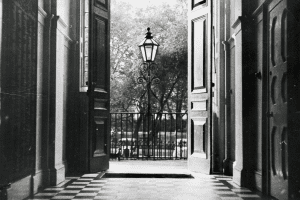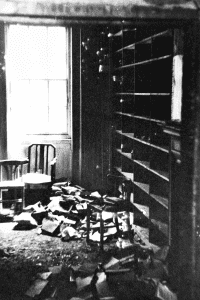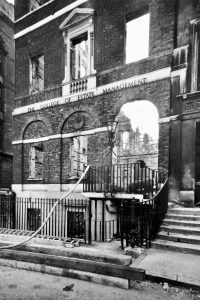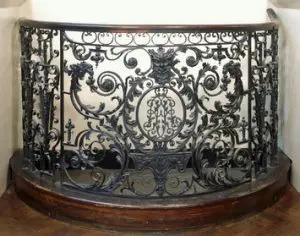Focus on our centenary: #UCEM100 blog catch-up. Iconic structures
Posted on: 28 August, 2019
We return to our #UCEM100 blog this month which focuses on our three themes which are: iconic structures; inspiring women in the Built Environment; and the World Wars. So far, we’ve looked at an alumnus’s involvement with the Crossrail project; the story of the UK’s first female Chartered Surveyor; and a Programme Leader’s involvement in the complex construction of the National Museum of Qatar.
This month, we are publishing two blogs – one telling the story of an inspiring female alumna and the first concerning two structures which hold special value to UCEM; namely, the UCEM lamp and our first home – 35 Lincoln’s Inn Fields.
UCEM lamp
The following is an extract from our forthcoming history book detailing the first 100 years of UCEM and explains why a lamp holds so much significance for the institution…
Then and now: The UCEM lamp outside the entrance of our first home at Lincoln’s Inn Fields and the very same lamp at our current Horizons home in Reading.
One item of great symbolism and significance that did come with UCEM to Horizons from the Whiteknights Campus is the lamp that stood outside the entrance to the URS Building and which has been in situ outside each of the institution’s main permanent offices since 1919.
A brass plaque accompanying the lamp reads:
‘This lamp was originally situated outside 35 Lincoln’s Inn Fields, London, the first permanent home of the College of Estate Management.
‘Later it was erected at the entrance to the College’s post-war premises in St Alban’s Grove, Kensington, London, and was subsequently transferred in 1972 to the new College and Faculty building, at the University of Reading, Whiteknights, Reading.
‘Finally, in 2016, it was transferred to Horizons, 60 Queen’s Road, Reading, the new permanent home of the now University College of Estate Management, where it stands proudly in the outside decking area as a reminder of our heritage.’
The lamp is a permanent reminder of our past and the journey the institution has been on to date and is iconic in the eyes of UCEM.
35 Lincoln’s Inn Fields
The College of Estate Management’s first permanent home was at 35 Lincoln’s Inn Fields, which CEM inhabited from its purchase in 1921 until the Second World War.
Drawings of the facade and entrance to 35 Lincoln’s Inn Fields
Lincoln’s Inn Field was an 18th-century house built in 1754 and designed by the renowned architect, Sir Robert Taylor. It had been the residence of a succession of distinguished lawyers and required a lot of money to restore the premises and adapt them to the needs of the College.
The number of students CEM had in 1921-22 was: Full-time – 11; Evening class – 184; and Postal courses – 615. As the number of full-time and evening class students grew, CEM extended the premises at the rear of 35 Lincoln’s Inn Fields to provide additional lecture halls and administrative offices.
Upon the outbreak of war, attempts were made to carry on with day and evening classes at Lincoln’s Inn Fields but these had to be abandoned with the main work of the College confined to postal tuition. Sadly, 35 Lincoln’s Inn Fields was lost by enemy action after, first, suffering damage in the autumn of 1940 and then being hit by incendiary bombs in the spring of 1941.
Before and after: The postal room at 35 Lincoln’s Inn Fields before the 1941 raid and after.
35 Lincoln’s Inn Fields after the 1941 raid
In 1943, Lincoln’s Inn Fields was sold to the Royal College of Surgeons.
Wrought iron staircase
Upon purchasing the property, CEM needed to remodel the interior in order to make the building suitable for its new educational purpose. This included removing an exquisite wrought iron staircase and balustrade, made in 1754 or earlier, in an intricate style akin to famous French Huguenot ironworker Jean Tijou.
In order to preserve the staircase, The College of Estate Management gifted it to the nation. On February 25th 1921, the piece was donated to the Victoria and Albert Museum, where it has been on display ever since.
To this day, you can view this artefact in room 54 of the Victoria and Albert Museum in Kensington.
We will be returning (almost!) to our first home next month when we host our exclusive student and alumni centenary event at Lincoln’s Inn. The venue is just a stone’s throw away from our former home and, as such, a perfect location to celebrate our centenary.














